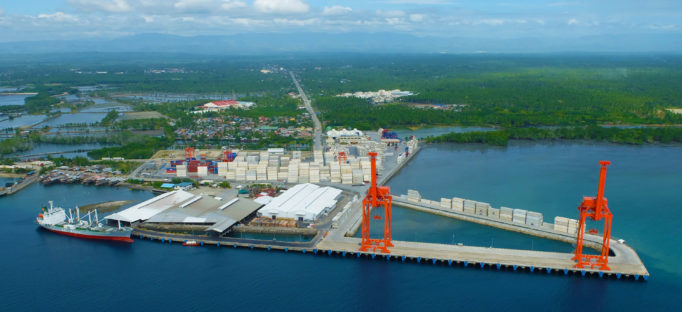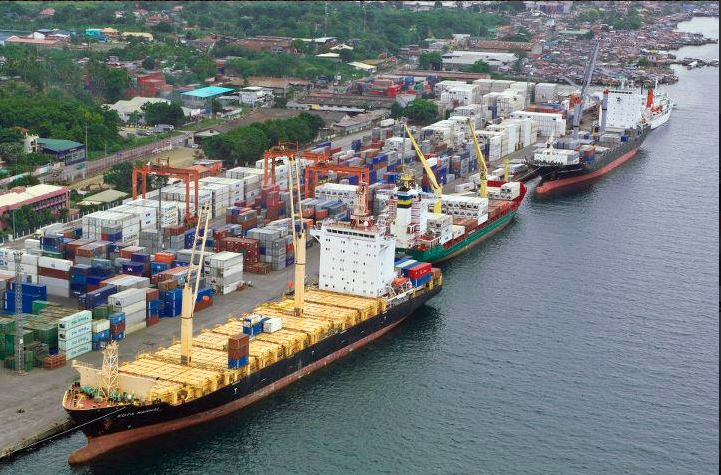The Port of Davao is a seaport located in the island of Mindanao. The Port of Davao consists of a number of ports, all within the Davao Gulf, which is part of the Celebes Sea, but its main office and seaport is located at Sasa, Davao City. The Sasa Wharf is one of the largest and busiest piers in the port area. Sasa Wharf is owned and operated by International Container Terminal Services Inc. (ICTSI). Operations at the Port of Davao are mainly comprised of container cargo; raw materials exportation, bulk cargo, general cargo; and passenger traffic.
The Port of Davao has a natural coastal harbor. It has a small dry dock and a small harbor with over 500 ft in length. Nevertheless, its anchorage depth is between 21.6m-22.9m deep; its cargo pier depth is between 9.4m-10m; and it oil terminal depth is between 6.4m-7.6m, all perfect for large cargo carriers and tankers. It has a transit shed of 1,200 sqm and 360 sqm for passenger terminals and parking. Its container yard is 33,000 sqm, with storage area of 20,000 sqm, and a warehouse of 6,000 sqm.
The Port of Davao is the gateway to southern Philippines, considered the most important port in Mindanao, as it is the busiest international container port serving both Visayas and Mindanao regions, and is the best-performing port in Mindanao.
Philippine Ports Authority (PPA) 2017 statistics show that the Port of Davao contributed 11.1% of the total container cargo nationwide (in TEUs), compared to Manila North Harbor at 12.3% and Manila South Harbor at 19.3%. Ship calls were 7.3%; cargo throughput (in MTs) is 6.4%; passenger traffic was 2.9%; but no RORO traffic was registered at all. There are actually some passenger shipping-lines that have operations to and from Davao, such as WG&A Superferry. Moreover, DOTr Under Secretary for Maritime Transportation Felipe Judan stated at the 135th Maritime Forum held at PPA HQ that “there are small passenger ferries traversing to and from Samal Island.” He also said that President Duterte had made a request for PPA to look into the feasibility of bringing back the old RORO operations in Davao. Commodore Chuck Agustin, former GM of PPA, explained that “the Port of Davao is far from the other ports in Mindanao, thus, it makes more sense for passengers to travel by land than by sea.” DOTr USEC Judan added, “the Duterte administration has plans of building a railway system soon between Davao and several points in Mindanao.”
The Port of Davao is a premier port. It is one of the country’s major seaports, which is comparable to the large ports of Manila, Subic, and Cebu. It includes Davao City and the four provinces: Davao del Norte; Davao del Sur; Davao Occidental; and Davao Oriental. The Port of Davao services inter-island and international shipments. Davao is along the shore of Davao Gulf in southwestern Mindanao.
In Davao del Sur, the City of Davao is located there but is politically and administratively independent of the province. The access to the port of entry is through Davao Gulf, is either at Pakiputan Strait along the waters of western Samal Island, or along the waters of eastern Samal Island.
In Davao Oriental, the Piso Point Port is primarily used for mineral stockpiling and exportation. The Tefasco Pier handles asphalt shipments and similar products. The Stevedorage Services Corporation Pier handles general cargo, bulk cargo, vehicles and lumber, all of which makes it one of the busiest piers in the port. The Caltex Pier and Petron Pier are also located in Davao Oriental. Access to Mati Port is through Pujada Bay.
Davao City and the Port of Davao have 2 government international seaports, Sasa Wharf and Sta. Ana Wharf, and 9 privately owned ports. In addition, the Toril international Fish Port Complex accommodates small and large-scale fishing activities, and provides cold-storage facilities. Anchorage in Davao is well protected except during southwest monsoons.
In Davao del Norte, the Davao International Container Terminal, Inc. (DICT) located in Panabo City has transformed Davao Region into the industry leader in port logistics in Mindanao. Panabo City is part of the Davao Metropolitan Area, which is the country’s largest metropolis, in terms of land area. DICT, a modern container port, is a joint venture between ANFLOCOR and Dole-Stanfilco, the leading producers and exporters of fresh Cavendish bananas in the Philippines. Tadeco, which covers 7,500 hectares of banana plantations in Panabo City, exports millions of boxes of Cavendish bananas, which is the main economic driver of the city. The agricultural cargoes are transported via refrigerated shipping containers called Reefers.

Photo Credit: Davao International Container Terminal (DICT)
The Php5 billion expansion of DICT in 2016 increased its handling capacity from 300K TEUs to 800K TEUs. Alex Valoria, President and CEO, Antonio Floirendo Group said, “From 2 quay cranes, we now have 4 quay cranes, 8 rubber-tired gantry cranes, and container handling equipment. The expanded DICT “offers world-class container terminal facilities and services in this heavily agricultural island in the Philippines, the DICT helps ensure the global competitiveness of Mindanao’s export-grade products.” Davao del Norte 2nd District Representative Antonio Floirendo Jr is the visionary who turned Panabo into an agro-industrial city, and regarded as “The Banana Capital of the Philippines.”
DICT container port has an area of 11 hectares, with a 15-hectare container yard, adjacent to a 70-hectare export-processing zone (EPZ), and has access to an 88-hectare mixed-use land in Panabo City. Its clients enjoy the EPZ benefits of duty-free importation of equipment, raw materials, and an income tax holiday. At least 9 major shipping lines do ship calls on DICT. These are: American President; Maersk MCC; CMA CGM; Wan Hai Shipping; Advance Container; Regional Container; Pacific International; Mariana Express; and Cosco Shipping Lines.
